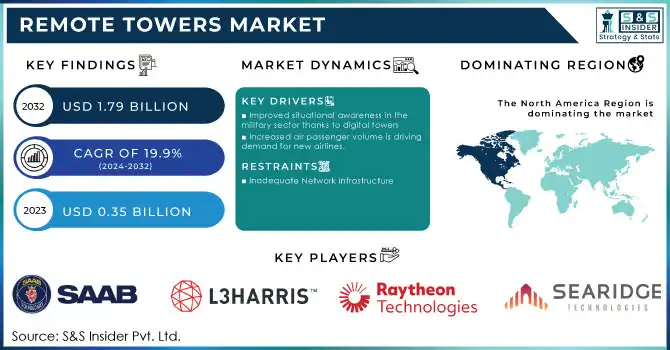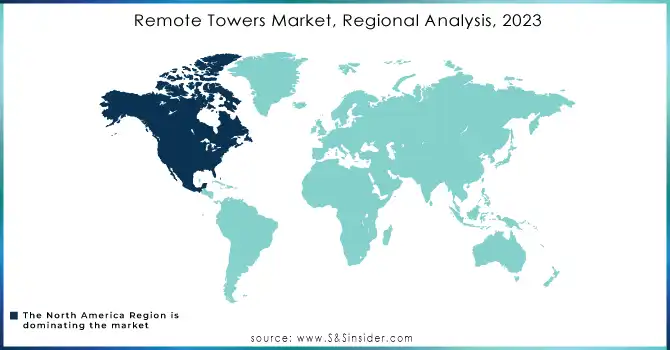Remote Towers Market Report Scope & Overview:

To get more information on Remote Towers Market - Request Free Sample Report
The Remote Towers Market Size was valued at USD 0.35 billion in 2023 and is expected to reach USD 1.79 billion by 2032 and grow at a CAGR of 19.9% over the forecast period 2024-2032.
Remote towers is an advanced and inexpensive concept where air traffic services are made from outside the airport. Remote towers include the use of aerospace and basic functions to ensure safe, economical, and efficient flight traffic management. The complete remote towers system contains airport equipment, remote tower modules, and network solutions. The technology used for remote towers involves a few parameters such as high-definition cameras, surveillance sensors and weather conditions, which give tower workers more information compared to conventional towers. With the help of remote towers, the air traffic service (ATS) can access the full view from the integration of fixed and moving digital video cameras in the remote control aircraft. Fixed cameras provide a large display as well as any other necessary additions such as a ramp closure. Similarly, moving cameras are also installed, which can be directed as needed in the RTS area which repeats how binoculars can be used in a conventional tower.
The trend to reduce operational expenses, combined with the proclivity to incorporate advanced electronics to automate every task, is the primary market driver. The Global Remote Towers Market study provides a comprehensive analysis of the market.The research examines important segments, trends, drivers, restraints, the competitive landscape, and market-significant factors in depth.
MARKET DYNAMICS
KEY DRIVERS
-
Improved situational awareness in the military sector thanks to digital towers
-
Increased air passenger volume is driving demand for new airlines.
RESTRAINTS
-
Inadequate Network Infrastructure
CHALLENGES
-
Automation risks and the necessity for considerable training and familiarity with new distant towers
-
Increased cyber threats to air traffic control
OPPORTUNITIES
-
The whole air traffic management sector is expanding.
-
Modernization of existing air traffic control infrastructure
IMPACT OF COVID-19
The COVID-19 issue has impacted research and development (R&D) in remote towers systems due to proclaimed lockdown and government prohibitions on public meetings.
Major airports throughout the world have been inoperable, delaying ongoing upgrades to airports using remote tower systems.
Because to COVID-19, the production rate of remote tower components such as numerous equipment and remote tower modules has decreased, negatively affecting the worldwide remote towers market.
Remote tower companies' business development opportunities have been harmed as a result of the overall scarcity in demand for remote tower systems caused by the COVID-19 epidemic.
Demand for remote towers may increase in the future as global governments begin to relax restrictions and flights are scheduled to restart soon.
Airports employ personnel to manage all aircraft arrival, departure, and ground movement. However, such conventional towers place financial strain on airports, particularly minor airports. Whereas remote tower technology is an effective alternative for such airports to increase income and possibly keep them open. Furthermore, remote tower technology improves security and keeps employees in a safe, secure, and protected location. Furthermore, when an airport expands, a remote tower can be a cost-effective alternative to building a new control tower. As a result, such advanced remote tower characteristics help to boosting the safety and efficiency of the air traffic system, consequently driving the growth of the worldwide remote towers market.
The market is divided into three segments based on system: airport equipment, remote tower modules, and network solutions. Airport Equipment held the biggest market share in 2023, and Remote Tower Modules is expected to grow at the quickest CAGR during the forecast period. A remote virtual tower is a location where air traffic services are delivered remotely by direct visual capture and visual reproduction devices such as webcams. A remote tower module is used to deliver the ATS, which includes an operator workstation, ATM systems, and display solutions. Around the world, there is a growing demand for remote tower modules.
The Global Remote Tower Market has been segmented into Communication, Information, Flight Control, Surveillance, Visualization, and Others. Air-ground and ground-ground voice conversations between the ATCO and the other players involved in the provision of ATS are included in voice/data communication. Voice/data communications through the air/ground: It corresponds to voice/data communication between ATCOs and the flying crew of an aircraft. Various considerations are increasing demand for the Remote Tower application segment in these industries.
The Global Remote Tower Market has been classified into three segments based on operation: single remote virtual tower, multiple remote virtual tower, and contingency remote virtual tower. In 2022, Single Remote Virtual Tower held the biggest market share, and Multiple Remote Virtual Tower is expected to grow at the quickest CAGR. The provision of an aerodrome ATS to a single airport from a digital tower is referred to as single-mode operations. Services will encompass all types of ATS and will rely on a suitable operational crew of one or more operators to ensure safe operations.
This mode generally refers to the continuous provision of ATS from a permanent digital tower facility, rather than a conventional tower. During the forecast period, these factors will support the expansion of the remote tower operating segment.
KEY MARKET SEGMENTATION
By Operation Type
-
Single
-
Multiple
-
Contingency
BySystem Type
-
Airport Equipment
-
Remote Tower Modules
-
Solutions & Software
By Application
-
Communication
-
Information & Control
-
Surveillance
-
Visualization
REGIONAL ANALYSIS
Because of the presence of important businesses such as ADB SAFEGATE and Searidge Technologies, North America dominated the remote towers market.
Europe The presence of major aircraft manufacturers such as Airbus S.A.S. and airport renovation initiatives in countries such as the United Kingdom and Germany are projected to promote regional market growth.
Asia-Pacific This region's market is expected to grow at the fastest rate during the forecast period. The burgeoning aviation industries in China, Japan, and India are likely to drive up demand for distant towers in the region.
World at Large Increased investments by significant airlines in countries such as Brazil, South Africa, and the Gulf Cooperation Council (GCC) are likely to enhance demand for remote towers in the region.

Need any customization research on Remote Towers Market - Enquiry Now
REGIONAL COVERAGE:
-
North America
-
USA
-
Canada
-
Mexico
-
-
Europe
-
Germany
-
UK
-
France
-
Italy
-
Spain
-
The Netherlands
-
Rest of Europe
-
-
Asia-Pacific
-
Japan
-
south Korea
-
China
-
India
-
Australia
-
Rest of Asia-Pacific
-
-
The Middle East & Africa
-
Israel
-
UAE
-
South Africa
-
Rest of Middle East & Africa
-
-
Latin America
-
Brazil
-
Argentina
-
Rest of Latin America
-
KEY PLAYERS
The Key Players are Saab AB, L3Harris Technologies, Inc., Raytheon Technologies Corporation, Lockheed Martin Corporation., Searidge Technologies, Thales Group, Frequentis Group, Indra Sistemas S.A., KONGSBERG, Northrop Grumman Corporation & Other Players
| Report Attributes | Details |
|---|---|
| Market Size in 2023 | US$ 0.35 Billion |
| Market Size by 2032 | US$ 1.79 Billion |
| CAGR | CAGR of 19.9% From 2024 to 2032 |
| Base Year | 2023 |
| Forecast Period | 2024-2032 |
| Historical Data | 2020-2022 |
| Report Scope & Coverage | Market Size, Segments Analysis, Competitive Landscape, Regional Analysis, DROC & SWOT Analysis, Forecast Outlook |
| Key Segments | • By Operation Type (Single, Multiple, Contingency) • By System Type (Airport Equipment, Remote Tower Modules, Solutions & Software) • By Application (Communication, Information & Control, Surveillance and Visualization) |
| Regional Analysis/Coverage | North America (USA, Canada, Mexico), Europe (Germany, UK, France, Italy, Spain, Netherlands, Rest of Europe), Asia-Pacific (Japan, South Korea, China, India, Australia, Rest of Asia-Pacific), The Middle East & Africa (Israel, UAE, South Africa, Rest of Middle East & Africa), Latin America (Brazil, Argentina, Rest of Latin America) |
| Company Profiles | Saab AB, L3Harris Technologies, Inc., Raytheon Technologies Corporation, Lockheed Martin Corporation., Searidge Technologies, Thales Group, Frequentis Group, Indra Sistemas S.A., KONGSBERG, Northrop Grumman Corporation |
| DRIVERS | • Improved situational awareness in the military sector thanks to digital towers • Increased air passenger volume is driving demand for new airlines. |
| RESTRAINTS | • Inadequate Network Infrastructure |

